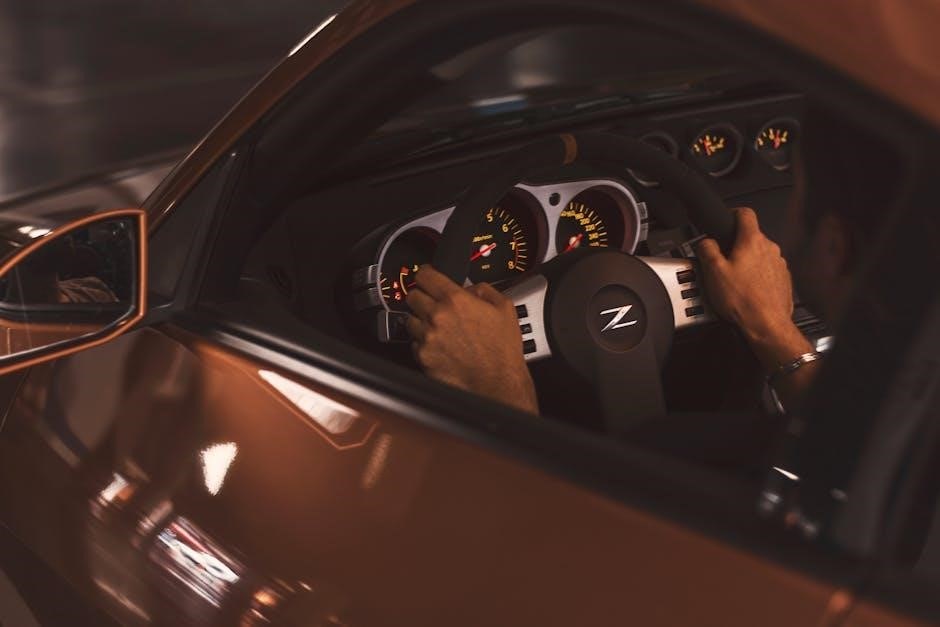350z Manual Swap: A Comprehensive Guide
Embark on the journey of transforming your 350z by swapping its automatic transmission for a more engaging manual gearbox. This guide provides comprehensive information, from parts needed to troubleshooting, ensuring a successful conversion of your Z.
The 350z manual swap is a popular modification, enhancing driving engagement. Many owners of automatic 350z models seek the increased control and performance offered by a manual transmission. This conversion involves replacing the automatic transmission with a 6-speed manual, requiring careful planning and execution. The process includes sourcing parts, understanding wiring complexities, and addressing potential issues like the U1000 code. Successfully completing the swap results in a more rewarding driving experience, bringing the 350z closer to its sporty potential. Considering all aspects ensures a smooth transition and avoids unexpected complications during the conversion.

Required Parts and Components
A successful 350z manual swap hinges on gathering all necessary parts. This section details the essential components, including the transmission, clutch kit, and associated hardware, ensuring a complete and functional conversion.
Essential Parts List for the Swap
To perform a 350z manual swap, acquiring the correct parts is crucial. The core component is a 6-speed manual transmission, ideally from a 350z or 370z. A clutch kit, including the disc, pressure plate, and throw-out bearing, is essential. You’ll need a flywheel, along with new bolts for both the flywheel and pressure plate. A manual transmission shifter, along with the appropriate trim and boot, is required for the interior. Don’t forget the clutch pedal assembly, master cylinder, and the necessary hydraulic lines. Finally, ensure you have the correct driveshaft and GL4 gear oil for the transmission.
Sourcing a Used 6-Speed Transmission
Finding a reliable used 6-speed transmission for your 350z manual swap is a critical step. Begin by checking local auto salvage yards; these often have 350z or 370z transmissions at competitive prices. Online marketplaces like eBay and specialized Nissan forums can also be valuable resources. When evaluating a potential transmission, inquire about its history, mileage, and previous usage. Ideally, obtain a transmission that has been tested and confirmed to be in good working condition. Ask if a warranty or return policy is available. Be aware that transmissions from 2005 and newer models are preferable.
Step-by-Step Swap Procedure
The manual swap involves careful removal of the automatic transmission, followed by precise installation of the manual transmission. Each step requires specific tools and attention to detail for a seamless transition.
Removing the Automatic Transmission
Begin by disconnecting the battery and draining the transmission fluid. Next, detach the driveshaft at the differential and remove its carrier bearing, allowing the driveshaft to be pulled out. Undo the transmission mount bolt, carefully lowering the transmission into the crossmember. Disconnect all sensors, the gear selector, and transmission cooler lines. Ensure all wiring harness connections are free before fully removing the automatic transmission. Proper support during removal is crucial to prevent damage. Remember to label all disconnected components for easy reinstallation or reference during the manual swap.
Installing the Manual Transmission
Begin by mounting the manual transmission to the engine, ensuring proper alignment and torque specifications for all bolts. Install the clutch and flywheel, adhering to the manufacturer’s guidelines for torque and procedure. Connect the shifter assembly and ensure smooth operation through all gears. Next, connect the driveshaft, ensuring correct length and proper installation at both the transmission and differential. Reconnect all sensors and wiring, paying close attention to grounding points. Finally, fill the transmission with the correct type and amount of gear oil. Double-check all connections before lowering the vehicle and testing the new manual transmission.
Wiring and Electrical Considerations
Successfully completing a 350z manual swap requires meticulous attention to wiring. The integration of the manual transmission necessitates modifications to the existing wiring harness and careful consideration of electrical components to ensure proper functionality.
Wiring Harness Modifications
Performing a manual swap on your 350z from an automatic requires careful modification of the existing wiring harness. This involves adapting the harness to accommodate the manual transmission’s specific needs, as the automatic transmission’s wiring is integrated with the ECM for operation. It is not easy and wont be cheap. Several wires must be re-routed or spliced to ensure proper functionality. You may have to locate the Orange wire at 6H on F102 and the Yellow wire at 23H on M72, cut both and splice them. Incorrect wiring can lead to malfunctions.
Reverse Lamp Wiring
A crucial step in the 350z manual swap involves correctly wiring the reverse lamps to ensure they function properly. This requires connecting the reverse light switch on the manual transmission to the vehicle’s electrical system. The wires go through the SMJ connector F102-M72 in different spots. Locate the Orange wire at 6H on F102 and the Yellow wire at 23H on M72, cut both and splice them. That will let the switch in the transmission ground the Reverse Lamp Relay coil just like the TCM did before the swap. Without this connection, the reverse lights will not activate.

Potential Issues and Troubleshooting
Manual swaps are not always smooth. Some potential problems that arise include the dreaded U1000 code or starting problems. Understanding these issues and knowing how to troubleshoot them is key to a successful swap.
Addressing U1000 Code
The U1000 code is a common issue following a 350z automatic to manual transmission swap. This code indicates a communication error within the CAN bus system. It often appears because the TCM (Transmission Control Module) is no longer present after removing the automatic transmission. The absence of the TCM disrupts the car’s computer system, leading to the U1000 code.
To resolve this, ensure proper wiring and connections, especially concerning the ECM. Investigate the main wiring harness, looking for loose connections. Cruise control functionality may be affected by this code, thus verifying cruise control function after addressing the code is crucial.
Starting Problems After the Swap
Encountering starting problems after a 350z manual swap can be frustrating, but common. One potential cause involves the neutral safety switch, which prevents the car from starting unless in neutral or with the clutch depressed. Ensure the clutch switch is properly installed and functioning, as it replicates the neutral safety function.
Another factor could be related to the alarm system or immobilizer. Issues with the wiring harness or ECM can lead to starting failures. Verify all connections related to the manual transmission swap, and check for any error codes. If the alarm light is on, this further suggests security system interference, requiring further investigation.

Alternative Swap Options and Considerations
Beyond the standard manual swap, explore alternatives like the CD009 transmission or an LS swap, each offering unique performance benefits. Carefully consider compatibility, cost, and required modifications for these options.
CD009 Transmission Swap
The CD009 transmission, known for its robustness, presents a viable alternative to the original 350Z manual transmission. This swap often involves adapter kits, especially when pairing with engines like the 2JZ. Consider that while the CD009 offers improved strength, modifications to the driveshaft and potentially the transmission tunnel might be necessary for proper fitment within the 350Z chassis. Check compatibility and thoroughly research any potential challenges or additional parts needed before proceeding with this swap, as the CD009’s dimensions and mounting points may differ from the factory transmission. Proper planning ensures a successful and reliable installation.
LS Swap with 350z Transmission
Integrating an LS engine with the 350Z’s manual transmission is an ambitious project, demanding meticulous planning. This combination necessitates an adapter plate to bridge the engine and transmission. While it offers increased power, be aware that the 350Z transmission’s strength becomes a limiting factor. Reinforcement or an upgrade to a sturdier transmission like the CD009 might be essential, considering the LS engine’s output. Careful consideration of the wiring harness and ECU is crucial for seamless integration. Suspension and braking upgrades may also be necessary to handle the added power. It’s a complex swap requiring expertise.

Cost and Time Estimates
The total cost for a 350Z manual swap varies significantly based on parts used and labor involved. Budget anywhere from $3,000 to upwards of $5,000 or more, including the transmission, clutch kit, and necessary hardware. Opting for aftermarket parts increases expenses. Professional installation adds labor costs. DIY approaches reduce expenses but demand expertise. Sourcing used parts can lower the initial outlay. Time-wise, a professional shop typically completes the swap in a week. DIY projects may span several weekends, depending on skill level and complications encountered. Unexpected issues could extend the timeline. Accurate budgeting and realistic scheduling are crucial for a smooth swap.
